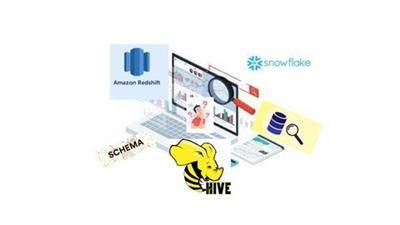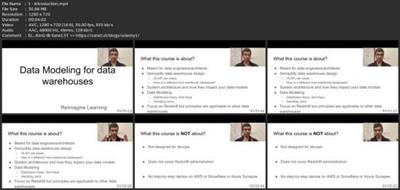M
0

Published 11/2022
MP4 | Video: h264, 1280x720 | Audio: AAC, 44.1 KHz
Language: English | Size: 1.14 GB | Duration: 2h 12m
Data modeling in a data warehouse
MP4 | Video: h264, 1280x720 | Audio: AAC, 44.1 KHz
Language: English | Size: 1.14 GB | Duration: 2h 12m
Data modeling in a data warehouse
What you'll learn
Understand the internal architecture of an OLAP store
Designing the data model to support rich analytical queries
Understand distribution and sort keys and how to leverage them
Designing your aggregation queries in a column-oriented OLAP store
Optimize Redshift Query Performance
Requirements
You understand the basics of SQL and now want to extend your skills to designing the data model for data warehouses
Description
Designing a data model for a data warehouse is fundamentally different from designing the schema for your primary database. A data warehouse is meant for supporting aggregation queries that touch a huge number of records and are very expensive. The scale in terms of number of queries is at least an order of magnitude less than the number of queries seen by a consumer-facing primary database. This distinction leads to a fundamental different data layout and indexing model in the database used in a data warehouse. Such databases are called OLAP databases.This course will take you into the internal architecture of an OLAP database with specific focus on areas that help you how a query runs on an OLAP database. We will walk though the levers that an OLAP database provides to optimize your queries. We will then cover various scenarios that will help you design the data model for an OLAP database used in a data warehouse.Throughout this course, we will use AWS Redshift as the OLAP database. However, the principles covered in this course are general and can be applied in any data warehouse including Snowflake or Hive. Some of these principles are also applicable in real-time column stores like HBase.
Overview
Section 1: Introduction
Lecture 1 Introduction
Lecture 2 OLTP Versus OLAP - part I
Lecture 3 OLTP versus OLAP - part II
Section 2: OLAP Architecture
Lecture 4 Data Layout and Distribution
Lecture 5 Query execution - I
Lecture 6 Query execution - II
Section 3: Data Modeling
Lecture 7 Avoiding Full Scans (Sort Keys) - 1
Lecture 8 Avoiding Full Scans (Sort Keys) - 2
Lecture 9 Distribution Keys
Lecture 10 Handling Joins - Part I
Lecture 11 Handling Joins - Part 2
Section 4: Beyond data modeling
Lecture 12 Beyond schema design
Data engineer and/or data architects

Download link
rapidgator.net:
You must reply in thread to view hidden text.
uploadgig.com:
You must reply in thread to view hidden text.
nitroflare.com:
You must reply in thread to view hidden text.
1dl.net:
You must reply in thread to view hidden text.


